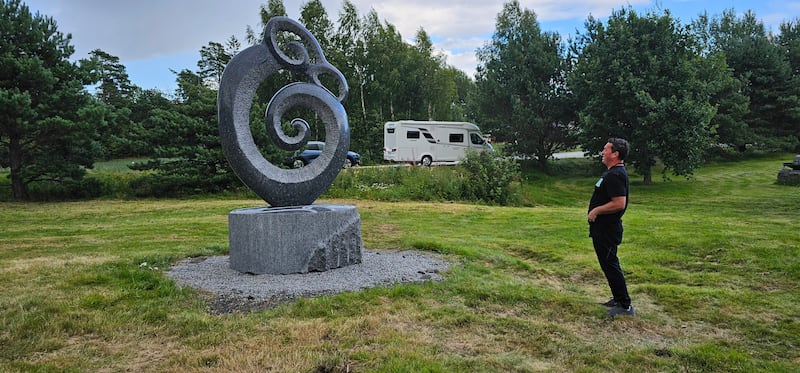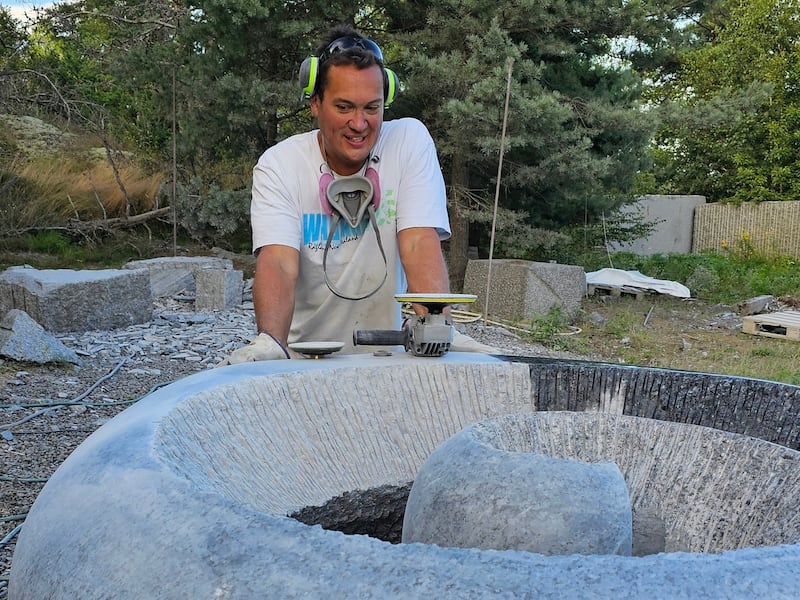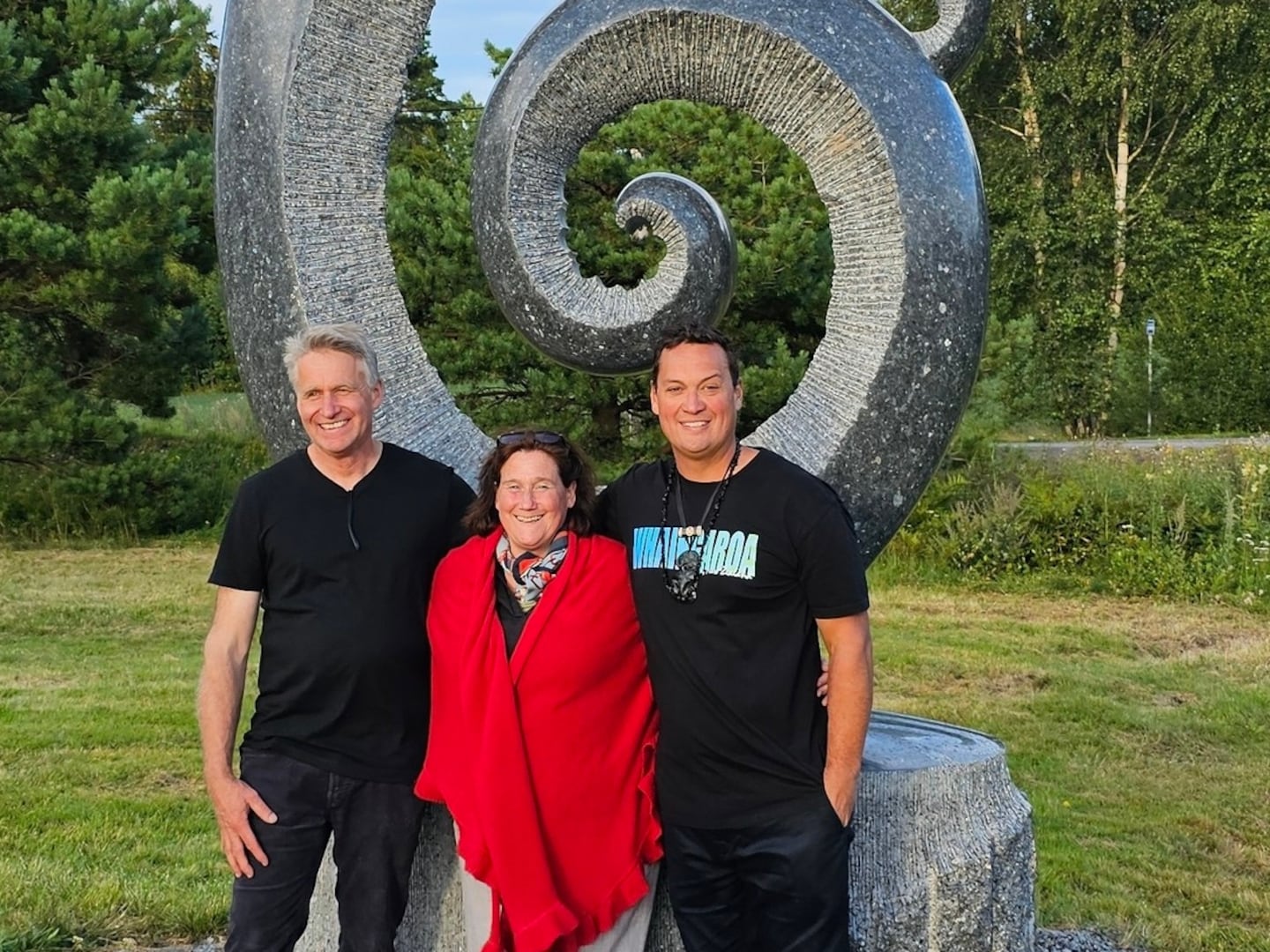Whāingaroa artist Simon Te Wheoro (Ngāti Māhanga, Ngāti Te Wehi, Ngāti Ranginui, Te Aupōuri) has created a striking toi Māori sculpture in Norway that has pushed him to new levels of growth and deepened his connection to te ao Māori.
“Doing this mahi always connects me with our tūpuna,” says Te Wheoro, who recently returned from Norway where he crafted the sculpture from stone.
“It’s my way of serving and acknowledging them, and I feel a deep connection through this work.”

Titled He Taonga Tuku Iho, He Taonga Māori, the sculpture stands 3.6 metres high and just under 2.5 metres wide.
“This name pays homage to my Māori heritage and acknowledges our tūpuna and the art forms passed down through generations.”
‘Many challenges’
Te Wheoro was one of only nine artists from across the world and the first New Zealander invited to participate in the 21st Symposium Norge in Tjodalyng, southern Norway, which has an almost 40-year history.
Living onsite by Stalaker Quarry, their task was to sculpt large-scale stone works from the local Larvikite blue-crystalline stone in just six weeks.
“Some of the biggest challenges I faced were the tight timeframe for completing the sculpture and the precision required when working on such a large scale.
“Unlike smaller sculptures, large pieces cannot be easily manoeuvred, so I had to trust in my decision-making and processes.”

There were other matters to overcome as well.
“There were many challenges, such as the time difference between Aotearoa and Norway, which made keeping in touch with my family difficult.
“The long working hours, combined with 19 hours of sunlight, took a toll on my body and mind, and it took a couple of weeks for my circadian rhythm to adjust.”
In Norway, he was alongside artists from Canada and the UK, plus those from Germany, Japan, Poland, Serbia and Turkey. “There were language barriers as well.”
‘Succeeded in mission’
Despite the challenges, there was a huge payoff for all his mahi.
“Sculpting the Larvikite stone horizontally and then seeing it upright at the end was a huge relief, looking exactly as I intended. Absolutely!”
Te Wheoro has grown from the experience.
“After six weeks of intense mahi, I’ve seen significant personal growth. My skills have developed, and my capabilities have been reassured.
“I set out to acknowledge Te Iwi Māori and our beautiful art forms, and I feel I succeeded in that mission.
“The challenge of working on such a large scale pushed me mentally and physically, [to] internal growth and a deeper connection to the spiritual aspects of my work.”

He has made many new friends as well, with exciting possibilities ahead.
“The highlight for me was sculpting Larvikite in Norway, representing Aotearoa alongside some of the world’s best sculptors at a prestigious level.
“I created great networks with amazing artists and have been invited to sculpt Carrara marble in Pietrasanta, Italy and Istanbul, Turkey.
“I will definitely stay in touch with the other eight sculptors and perhaps invite them to Aotearoa, hosting them at a symposium here in Whaingaroa.”
‘Deeply appreciated’
Te Wheoro is grateful to all those who took him into their hearts to support and cheer him on.
“I’d like to take this opportunity to thank everyone for their support and aroha while I was in Norway; it was deeply appreciated.
“My thanks to the hosts and organisers, Christine Dingens and Martin Kuhn, for their warmth, hospitality and support over the six weeks of the symposium in Norway.
“And a special thanks to my beautiful lady, Jamie Haenga, for allowing me to pursue my journey through sculpture and for supporting me and our family.”
‘Forever proud’
Te Wheoro says he is immensely proud to have shared something of Māori culture with those in Norway.
“I am forever proud and privileged to be a descendant of Rangatiratanga.
“Without sounding egotistic, our Māori culture and values were not only recognised but embraced by everyone. They were blown away with what I believe is our kaitiakitanga, our manaakitanga - essentially, our Māori values.
“Toitū te iwi Māori me ngā taonga tuku iho, Mauri ora ki a tātou katoa.”

